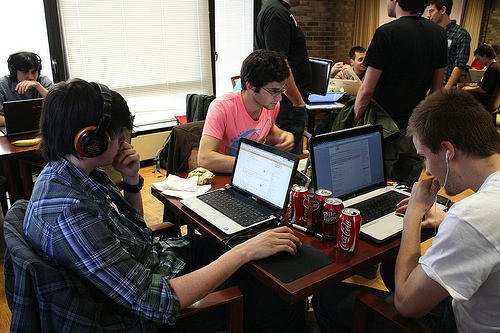Online education providers are embracing Utah’s cutting-edge digital learning law, but they’re struggling for guidance as high school students enrolled in brick-and-mortar schools sign up for virtual courses this fall.
Gov. Gary Herbert (R) signed Senate Bill 65, the first law in the nation to incorporate all 10 elements of high-quality learning the Digital Learning Council proposed last year. For the program’s first two years, Utah students enrolled in a traditional or public charter school can take up to two high school-level courses from approved digital providers through the new Statewide Online Education Program (SOEP).
“Utah is leading the nation with a student-centric online policy that empowers parents and students with the ability to choose the course and provider that best meet their individual learning and academic needs,” said Robyn Bagley, board chair of Parents for Choice in Education (PCE), a Salt Lake City-based grassroots group.
‘Dragging Their Feet’
On June 30, more than two months after Herbert signed SB 65, the Utah State Board of Education adopted emergency rules for implementing SOEP. Adopted just before a July 1 deadline, the rules apply until the end of the calendar year, when permanent regulations must be adopted.
“They’re dragging their feet because this is bucking the status quo,” said Open High School of Utah Director DeLaina Tonks.
Providers say the rules provide insufficient guidance on crucial details, such as how the provider will discover a student has signed up for a class.
“There’s a lot of muddy water here, and I’m not sure who can drop the chlorine into it,” said Laura Belnap, director of the Washington Online program. “It will be an experience to see how this all comes out and gets cleaned up.”
A provider can include any district or charter school that contracts with a private entity or operates its own online program. Current private and homeschool students can participate starting in the 2013-14 school year.
Shifting Funds, Performance Focus
A student’s home district must pay $726 for each full-year course a student opts to take online. The fiscal impact on local agencies raises concerns among some officials.
“While that’s fine for larger districts, because they can absorb those kinds of costs, charter schools and smaller districts can’t,” said State Board of Education member David Thomas. “They have the same overhead as they would have had before.”
The flat fee will be temporary, though, and providers look forward to a more sophisticated model designed for future years. Tonks says she favors “a tiered system that pays more exact amounts based on what it costs to take the class.”
Funding is also performance-based. Providers will receive half the money up front, and the other half upon the student’s successful completion.
“It shifts the emphasis to student outcomes,” said Michael Horn, executive director of education for the Innosight Institute. “If anything gets in the way of that, policymakers should move fast to correct for the unintended consequences and keep their eye on the students.”
The Utah Electronic High School receives $2 million annually to provide supplemental online courses. Starting in 2012-13, the new funding arrangement means Electronic High must compete with other providers.
Interest Building, Wrinkles to Iron
Washington Online currently serves about 1,000 students statewide with its full-time, publicly funded virtual program. As of late July, approximately 150 students had expressed interest in its new program created by SB 65.
Belnap said student attractions range from not wanting to take a course from a particular teacher in their district to wanting to graduate early.
Thomas said the new law’s proscription against students taking free courses beyond the required amount has limited choices in some cases. For example, a student who previously took band and orchestra concurrently while using an online course for physical education now may end up paying a fee.
“That really needs to change for this to be truly successful,” he said.
The Open High School of Utah, which currently serves nearly 400 students in its full-time online charter program, had received about 80 pre-registration inquiries by late July. Most interest from the prospective students has been in core and Advanced Placement courses. But many students must wait to act until their school counselors return to work in August.
Jetsons vs. Flinstones
Bagley says PCE is engaged in a promotional campaign to make students aware of their new online options for the coming school year.
“The more [Local Education Authorities] who choose to join rather than resist will strengthen the success of the program and likely cause a domino effect encouraging others to do the same,” said Bagley, whose organization is also preparing to defend against anticipated 2012 legislative efforts to roll back SB 65.
As Utah reformers prepare to protect their gains, Horn notes other state lawmakers can go further in devising a strong, student-centered blended learning program, especially by focusing on measures of instructional effectiveness.
“They should also think seriously about putting into place strong end-of-course assessments to make sure that incentives for completion are aligned around student needs, and not those of the providers,” said Horn.
But even as Utah struggles over implementation hurdles, some Tonks says the state has taken a major step toward shifting the education paradigm.
“This is where Utah paves the way for the Jetsons generation to flourish despite the grumblings from the Flintstones era crowd,” Tonks said.




